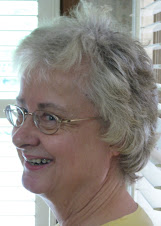
4-shaft crackle has 4 units. Some writers call them blocks. They are not, however true blocks because they do not weave independently of each other. Whenever one unit weaves, so does another. For me, this is what makes the structure so fascinating. This combining of units/blocks involves an interplay of colors between warp and weft that is unlike what happens in true block weaves, Summer and Winter, for example.
Watch my language when I talk about crackle. I will frequently lapse into using the word block. Why? Because often, depending on how I weave the crackle, the effect is of blocks. Take a look at the picture I posted on Friday. Doesn't it look like blocks? The weaving program I use has the capability of block substitution. What is one of the structures that I can use? Crackle.
And here are the threading units for 4-shaft crackle. I read the units right-to-left. And right-to-left is how I thread. I usually repeat these units, anywhere from 2 to 15 times. Remember, I frequently weave crackle between 50 and 60 epi. When I move from Unit A to Unit B, I thread the last thread of the preceding unit, but move immediately to the second thread of Unit B, omitting the heddle on shaft 2. However, when I repeat Unit B a second (or third, or fourth..........) time, I include the heddle on shaft 2. Moving from shaft 2 to shaft 3, the same thing. I include the last heddle on shaft 3, but drop the first heddle on shaft 3 in Unit C. Again, if I repeat Unit C, I include that first thread on shaft 3 with each repeat. Moving on to threading unit D, I thread the last heddle of Unit C (shaft 4) but omit the first thread of Unit D (shaft 4). If I repeat Unit D, I always, with each repeat, include that first heddle on shaft 4. And then back again to Unit A.




So, a simple threading with each unit repeated a second time would be what you see at the top of this post.
And, if you were to repeat this sequence, you would omit from Unit A, the heddle on the first shaft (shaft 1), but keeping it with each repeat.
These funny little first and last threads, one of which must be omitted when moving on to threading the next unit, are called incidentals. I don't know why they are called that. But which thread is the so-called incidental? The first on the new unit or the last on the old unit? I don't think it much matters.
The real purpose these incidentals serve, as I found when I started threading units out of order, is keep to the odd-even shaft combination going, not, as it might look at first glance, to prevent the repetition of a heddle (though it does that too). Doing this preserves a true tabby when you throw the tabby wefts.
More later.





3 comments:
I actually understand what you are saying! Well written. I am usually a visual person who needs to see something rather than just read words about it, but I grasp everything you've said. It seems though, that it would be tough to plan how many ends are required for a crackle project. I have to admit that it took me a long time to understand block theory. No one seemed to have a good explanation. I still puzzle over it sometimes.
Just want to say a big thank you for all the info that you've shared re: your exploration and experimentation with crackle. I chose crackle as the subject of my guild's first study topic and found your blog while searching for info online - it's definitely as inspiring as it is informative.
Janet, I'm glad that you have found my blog helpful. Thank you for sharing that.
Post a Comment